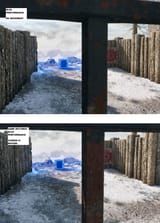Search Results
7/8/2025, 3:21:30 AM
It is an algorithm that is trained on high resolution, and then when it observes the low resolution image, it can reconstruct it as it would be at a higher resolution. Since NVidia GPUs have dedicated chips for this, the process is fast enough for imagem reconstruction to be in real time.
The problem is that it is a temporal solution. The longer you stay on the same image, the better the reconstruction. The effect collapses completely when you are moving and something in the foreground is blocking the background constantly, as in the pic related, where the fence near the screen is constantly blocking the image behind it, so when you move there is a severe degradation in image quality.
>but that's caused by TAA!
No, you can clearly see that the resolution as a whole has been affected on the moving screen, you can see fewer pixels on the fence, for example
>but it's imperceptible in real conditions
In fact, the effect is always noticeable, to a greater or lesser extent. The moving image is always of poorer quality than the image when you are stationary, with DLSS turned on.
The problem is that it is a temporal solution. The longer you stay on the same image, the better the reconstruction. The effect collapses completely when you are moving and something in the foreground is blocking the background constantly, as in the pic related, where the fence near the screen is constantly blocking the image behind it, so when you move there is a severe degradation in image quality.
>but that's caused by TAA!
No, you can clearly see that the resolution as a whole has been affected on the moving screen, you can see fewer pixels on the fence, for example
>but it's imperceptible in real conditions
In fact, the effect is always noticeable, to a greater or lesser extent. The moving image is always of poorer quality than the image when you are stationary, with DLSS turned on.
6/28/2025, 3:57:58 PM
>>713892520
I think you're blind
I think you're blind
Page 1
